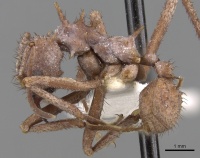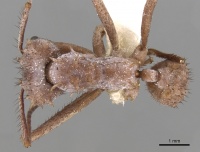Acromyrmex hystrix
| Acromyrmex hystrix | |
|---|---|

| |
| Scientific classification | |
| Kingdom: | Animalia |
| Phylum: | Arthropoda |
| Class: | Insecta |
| Order: | Hymenoptera |
| Family: | Formicidae |
| Subfamily: | Myrmicinae |
| Tribe: | Attini |
| Genus: | Acromyrmex |
| Species: | A. hystrix |
| Binomial name | |
| Acromyrmex hystrix (Latreille, 1802) | |
| Subspecies | |
| |
| Synonyms | |
| |
Identification
Distribution
Latitudinal Distribution Pattern
Latitudinal Range: 5.25° to -34.92125°.
| North Temperate |
North Subtropical |
Tropical | South Subtropical |
South Temperate |
- Source: AntMaps
Distribution based on Regional Taxon Lists
Neotropical Region: French Guiana (type locality), Guyana, Suriname, Uruguay.
Distribution based on AntMaps
Distribution based on AntWeb specimens
Check data from AntWeb
Countries Occupied
| Number of countries occupied by this species based on AntWiki Regional Taxon Lists. In general, fewer countries occupied indicates a narrower range, while more countries indicates a more widespread species. |

|
Estimated Abundance
| Relative abundance based on number of AntMaps records per species (this species within the purple bar). Fewer records (to the left) indicates a less abundant/encountered species while more records (to the right) indicates more abundant/encountered species. |

|
Biology
|
Castes
Nomenclature
The following information is derived from Barry Bolton's Online Catalogue of the Ants of the World.
- hystrix. Formica hystrix Latreille, 1802c: 230, pl. 10, fig. 61 (w.) FRENCH GUIANA.
- Type-material: holotype worker.
- Type-locality: French Guiana: Cayenne (no collector’s name).
- Type-depository: unknown (holotype lost (Santschi, 1925a: 357)).
- Emery, 1888c: 357 (m.).
- Combination in Myrma: Billberg, 1820: 104;
- combination in Atta: Haliday, 1836: 328; Roger, 1863b: 35;
- combination in Oecodoma: Lepeletier de Saint-Fargeau, 1835: 178; Smith, F. 1858b: 186; Mayr, 1863: 438;
- combination in Atta (Acromyrmex): Mayr, 1865: 83; Forel, 1885a: 355;
- combination in Acromyrmex: Santschi, 1925a: 357.
- Junior synonym of octospinosus: Dalla Torre, 1893: 153; Forel, 1893e: 590; Emery, 1894c: 220; Forel, 1895b: 139; Forel, 1899c: 34; Emery, 1905c: 44; Wheeler, W.M. 1911f: 158; Santschi, 1913h: 41; Emery, 1924d: 350.
- Status as species: Fabricius, 1804: 414; Lepeletier de Saint-Fargeau, 1835: 178 (redescription); Haliday, 1836: 328; Smith, F. 1858b: 186; Mayr, 1863: 438; Roger, 1863b: 35; Mayr, 1884: 37; Mayr, 1865: 83; Forel, 1885a: 362 (in key); Forel, 1886a: 217; Emery, 1888c: 357; Emery, 1890a: 66. Emery, 1890b: 55; Emery, 1894k: 58; Santschi, 1925a: 357; Borgmeier, 1927c: 132; Santschi, 1939e: 319 (in key); Santschi, 1939f: 164; Weber, 1946b: 153; Gonçalves, 1961: 143; Kempf, 1970b: 337; Kempf, 1972a: 12; Zolessi, et al. 1988: 4; Cherrett & Cherrett, 1989: 50; Brandão, 1991: 323; Bolton, 1995b: 55; Bezděčková, et al. 2015: 114; Fernández, et al. 2015: 57 (redescription); Fernández & Serna, 2019: 833.
- Senior synonym of emilii: Santschi, 1925a: 357; Borgmeier, 1927c: 132; Santschi, 1939e: 319 (in key); Gonçalves, 1961: 143; Kempf, 1972a: 12; Bolton, 1995b: 55; Fernández, et al. 2015: 57.
- Distribution: Brazil, Colombia, French Guiana, Guyana, Peru, Uruguay.
- Current subspecies: nominal plus ajax.
- emilii. Atta (Acromyrmex) emilii Forel, 1904c: 32 (w.) BRAZIL (Pará).
- Type-material: syntype workers (number not stated).
- Type-locality: Brazil: Pará, Guamá (E.A. Göldi).
- Type-depository: MHNG.
- Wheeler, G.C. 1949: 675 (l.).
- Combination in Acromyrmex: Mann, 1916: 454.
- Status as species: Emery, 1905c: 44; Mann, 1916: 454; Wheeler, W.M. 1916c: 11; Emery, 1924d: 349.
- Junior synonym of hystrix: Santschi, 1925a: 357; Borgmeier, 1927c: 132; Santschi, 1939e: 319 (in key); Gonçalves, 1961: 143; Kempf, 1972a: 12; Bolton, 1995b: 55; Fernández, et al. 2015: 51.
Description
References
- Albuquerque, E., Prado, L., Andrade-Silva, J., Siqueira, E., Sampaio, K., Alves, D., Brandão, C., Andrade, P., Feitosa, R., Koch, E., Delabie, J., Fernandes, I., Baccaro, F., Souza, J., Almeida, R., Silva, R. 2021. Ants of the State of Pará, Brazil: a historical and comprehensive dataset of a key biodiversity hotspot in the Amazon Basin. Zootaxa 5001, 1–83 (doi:10.11646/zootaxa.5001.1.1).
- Emery, C. 1888c [1887]. Formiche della provincia di Rio Grande do Sûl nel Brasile, raccolte dal dott. Hermann von Ihering. Bull. Soc. Entomol. Ital. 19: 352-366 (page 357, male described)
- Emery, C. 1894d. Studi sulle formiche della fauna neotropica. VI-XVI. Bull. Soc. Entomol. Ital. 26: 137-241 (page 220, subspecies of octospinosus)
- Emery, C. 1924f [1922]. Hymenoptera. Fam. Formicidae. Subfam. Myrmicinae. [concl.]. Genera Insectorum 174C: 207-397 (page 350, junior synonym of octospinosus)
- Forel, A. 1893h. Note sur les Attini. Ann. Soc. Entomol. Belg. 37: 586-607 (page 590, subspecies of octospinosus)
- Franco, W., Ladino, N., Delabie, J.H.C., Dejean, A., Orivel, J., Fichaux, M., Groc, S., Leponce, M., Feitosa, R.M. 2019. First checklist of the ants (Hymenoptera: Formicidae) of French Guiana. Zootaxa 4674, 509–543 (doi:10.11646/zootaxa.4674.5.2).
- Gonçalves, C. R. 1961. O genero Acromyrmex no Brasil (Hym. Formicidae). Stud. Entomol. 4: 113-180 (page 143, see also)
- Haliday, A. H. 1836. Descriptions, etc. of the Hymenoptera. Pp. 316-331 in: Curtis, J., Haliday, A. H., Walker, F. Descriptions, etc. of the insects collected by Captain P. P. King R. N., F. R. S., in the survey of the Straits of Magellan. Trans. Linn. (page 328, Combination in Atta)
- Latreille, P.A. 1802. Histoire naturelle des fourmis, et recueil de mémoires et d'observations sur les abeilles, les araignées, les faucheurs, et autres insectes. Paris: Impr. Crapelet (chez T. Barrois), xvi + 445 pp.
- Mayr, G. 1865. Formicidae. In: Reise der Österreichischen Fregatte "Novara" um die Erde in den Jahren 1857, 1858, 1859. Zoologischer Theil. Bd. II. Abt. 1. Wien: K. Gerold's Sohn, 119 pp. (page 83, Combination in Atta (Acromyrmex))
- Santschi, F. 1925a. Revision du genre Acromyrmex Mayr. Rev. Suisse Zool. 31: 355-398 (page 357, Combination in Acromyrmex, Revived from synonymy, revived status as species, and senior synonym of emilii)
References based on Global Ant Biodiversity Informatics
- Brandao, C.R.F. 1991. Adendos ao catalogo abreviado das formigas da regiao neotropical (Hymenoptera: Formicidae). Rev. Bras. Entomol. 35: 319-412.
- Culebra Mason S., C. Sgarbi, J. Chila Covachina, J. M. Pena, N. Dubrovsky Berensztein, C. Margaria, and M. Ricci. 2017. Acromyrmex Mayr (Hymenoptera: Formicidae: Myrmicinae): species distribution patterns in the province of Buenos Aires, Argentina. Rev. Mus. Argentino Cienc. Nat. 19(2) 185-199.
- Dattilo W., R. E. Vicente, R. V. Nunes, and M. Soares Gigliotti Carvalho. 2010. First Record of the Quenquém cisco-da-Amazônia Acromyrmex hystrix (Latreille) (Formicidae: Myrmicinae) for Maranhão State, Brazil. EntomoBrasilis 3 (3): 92-93.
- Emery C. 1890. Studii sulle formiche della fauna neotropica. Bull. Soc. Entomol. Ital. 22: 38-8
- Emery C. 1890. Voyage de M. E. Simon au Venezuela (Décembre 1887 - Avril 1888). Formicides. Annales de la Société Entomologique de France (6)10: 55-76.
- Emery C. 1894. Estudios sobre las hormigas de Costa Rica. Anales del Museo Nacional de Costa Rica 1888-1889: 45-64.
- Escalante Gutiérrez J. A. 1993. Especies de hormigas conocidas del Perú (Hymenoptera: Formicidae). Revista Peruana de Entomología 34:1-13.
- Fernández F., and E. E. Palacio. 1995. Hormigas de Colombia IV: nuevos registros de géneros y especies. Caldasia 17: 587-596.
- Fernández, F. and S. Sendoya. 2004. Lista de las hormigas neotropicales. Biota Colombiana Volume 5, Number 1.
- Franco W., N. Ladino, J. H. C. Delabie, A. Dejean, J. Orivel, M. Fichaux, S. Groc, M. Leponce, and R. M. Feitosa. 2019. First checklist of the ants (Hymenoptera: Formicidae) of French Guiana. Zootaxa 4674(5): 509-543.
- Gonçalves C. R. 1961. O genero Acromyrmex no Brasil (Hym. Formicidae). Stud. Entomol. 4: 113-180.
- Kempf, W.W. 1972. Catalago abreviado das formigas da regiao Neotropical (Hym. Formicidae) Studia Entomologica 15(1-4).
- Mann W. M. 1916. The Stanford Expedition to Brazil, 1911, John C. Branner, Director. The ants of Brazil. Bulletin of the Museum of Comparative Zoology 60: 399-490
- Mayhe-Nunes A. J., and K. Jaffe. 1998. On the biogeography of attini (Hymenoptera: Formicidae). Ecotropicos 11(1): 45-54.
- Overal W. L., A. Y. Harada, and B. M. Mascarenhas. 1997. As formigas. In: ed. P. L. B. Lisboa, 369379. Museu Paraense Emílio Goeldi, Belém, Brazil.
- Pires de Prado L., R. M. Feitosa, S. Pinzon Triana, J. A. Munoz Gutierrez, G. X. Rousseau, R. Alves Silva, G. M. Siqueira, C. L. Caldas dos Santos, F. Veras Silva, T. Sanches Ranzani da Silva, A. Casadei-Ferreira, R. Rosa da Silva, and J. Andrade-Silva. 2019. An overview of the ant fauna (Hymenoptera: Formicidae) of the state of Maranhao, Brazil. Pap. Avulsos Zool. 59: e20195938.
- Radoszkowsky O. 1884. Fourmis de Cayenne Française. Trudy Russkago Entomologicheskago Obshchestva 18: 30-39.
- Santschi F. 1925. Revision du genre Acromyrmex Mayr. Revue Suisse de Zoologie 31: 355-398.
- Weber N. A. 1946. The biology of the fungus-growing ants. Part IX. The British Guiana species. Revista de Entomologia (Rio de Janeiro) 17: 114-172.
- Weber N. A. 1947. Lower Orinoco River fungus-growing ants (Hymenoptera: Formicidae, Attini). Boletín de Entomologia Venezolana 6: 143-161.
- Wheeler G. C. 1949. The larvae of the fungus-growing ants. Am. Midl. Nat. 40: 664-689.
- Wheeler W. M. 1916. Ants collected in British Guiana by the expedition of the American Museum of Natural History during 1911. Bulletin of the American Museum of Natural History 35: 1-14.
- Wheeler W. M. 1937. Mosaics and other anomalies among ants. Cambridge, Mass.: Harvard University Press, 95 pp.
- Zolessi L. C. de, Y. P. Abenante, and M. E. de Philippi. 1988. Lista sistematica de las especies de Formicidos del Uruguay. Comun. Zool. Mus. Hist. Nat. Montev. 11: 1-9.

